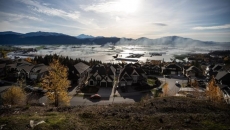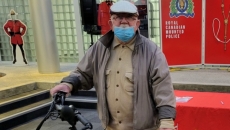VANCOUVER - Environment Canada is warning that up to 200 mm of rain could drench the central coast of British Columbia and parts of Vancouver Island through to Wednesday as a third atmospheric river hits the province.
It says heavy downpours could cause water pooling on roads and flooding in low-lying areas, with snowmelt possibly adding to increased runoff with mild temperatures at higher altitudes.
The agency is also forecasting strong southerly winds over exposed coastal sections as part of a storm packing heavy rain.
Inland sections of the coast including Bella Bella are expected to get up to 120 mm of rain starting Monday evening, and motorists are being told to avoid driving through water on roads.
"Even shallow, fast-moving water across a road can sweep a vehicle or a person away," the agency says in a written statement. "Be prepared for winter conditions at higher elevations."
Heavy snow followed by freezing rain and heavy rain are being forecast for the north coast, including Kitimat, Stewart and Terrace.
Environment Canada says up to 60 mm of rain and between 10 and 40 cm of snow are expected until Tuesday night.
"Prepare for quickly changing and deteriorating travel conditions. Visibility may be suddenly reduced at times in heavy snow," the statement says.
Between 50 and 100 mm of rain is expected for Metro Vancouver, the Fraser Valley, Howe Sound, Whistler and the Sunshine Coast as the third rainstorm in less than a week is set to bring heavy rain to the region.
The weather office said more than 100 millimetres of rain drenched the Fraser Valley city of Abbotsford over the weekend, while more fell in Hope.
Flood warnings have been issued for the Coldwater, Coquihalla, Nicola and Tulameen rivers, which all caused serious flood damage earlier this month to cities and towns along their banks, including Merritt, Spences Bridge, Princeton and Hope.
A flood warning also remains in effect for the Sumas River through Abbotsford, where rising levels forced crews to set up a portable dam Sunday night to protect a key stretch of Highway 1.
The highway was remains closed indefinitely between McCallum Road in Abbotsford and Yale Road in Chilliwack because of the threat of flooding.
Abbotsford Mayor Henry Braun said the focus is on flooding of the Nooksack River in Washington state because its high waters have the potential to further inundate low-lying areas.
TODAY // November 29
— Henry Braun (@MayorHenryBraun) November 29, 2021
Live update at 2 PM.https://t.co/UeiBK8lWOA
.
.
.#AbbotsfordBC #SumasPrairie #HuntingdonVillage #MastquiPrairie #YXX #BCfloods #BCstorm #FraserValley pic.twitter.com/QWmTRoxSJO
A social media post by the City of Sumas in Washington says floodwaters from the river continue to move north toward Canada but had not yet reached a key bridge about half a kilometre from the border.
"When that happens we will use the flood siren once again," the post said Monday.
"At that time we will recommend everyone shelter in place. Most of the roads in and out of Sumas are already closed. Please do not panic. Make any necessary preparations now."
A precautionary evacuation order was issued for some Abbotsford properties late Sunday. Several more homes were also placed on evacuation alert after a mudslide threatened properties on a hillside north of Highway 1, away from the Sumas flooding.
Public Safety Minister Mike Farnworth has said the province is prepared to use Alert Ready, a system that pushes emergency notifications directly to cellphones, if local authorities believe the next storm poses a threat to life or public safety.
Join Mike Farnworth, Minister of Public Safety & Solicitor General; Bruce Ralston, Minister of Energy, Mines & Low Carbon Innovation; Rob Fleming, Minister of Transportation & Infrastructure; and officials for an update on BC's response to flooding events. https://t.co/fq1JS6cggM
— BC Government News (@BCGovNews) November 29, 2021






